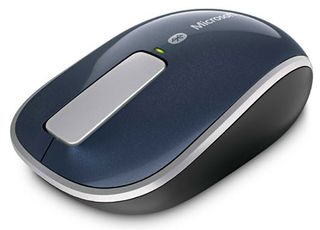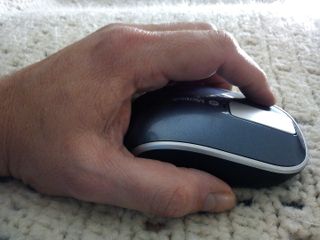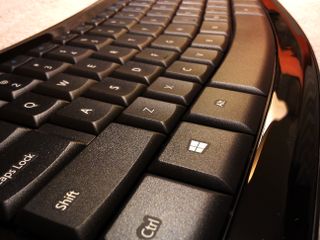Hands-on: Microsoft's Sculpt Touch Mouse, Sculpt Mobile Keyboard Designed for Windows 8
We check out Microsoft's Windows 8-ready Sculpt Touch Mouse and Sculpt Mobile Keyboard.
In the next few hands-on installments, I'm going wrap up Microsoft's coverage with three Windows 8 devices and one Windows 7 device. This latter device, the sleek and slick Touch Mouse, fits within this batch of Windows 8 gadgets because Microsoft is adding to it Windows 8-specific commands.

But first let's start with the "designed for Windows 8" peripherals. Out of all the gadgets Microsoft has tossed our way, I've used the Sculpt Touch Bluetooth Mouse the most, shown above. That's probably due to its form factor: it fits nicely in the palm of my hand, or rather, it's just right. It's not too small and it's not too big. It's a straight-to-the-point mouse I can control on nearly any surface with ease without having to cramp my hand or extend my fingers to uncomfortable lengths.
To make control easier, Microsoft has partnered this "just right" contoured shape with a layer of rubber along the sides and front, making it easier to grip. Two additional strips running across the width of the bottom raise the mouse just slightly off the surface so that it doesn't drag during movement – it's like pushing a toy car across the carpet (you've done it, don't deny it). Also located on the bottom is a power switch for conserving the batteries (two AA), a Bluetooth switch for pairing, and the BlueTrack sensor.

Microsoft promotes this mouse as Windows 8 ready, but it works just fine in Windows 7. Replacing the old-school mouse wheel is a touch strip that provides 4-way scrolling. Flick up on the strip to scroll up, flick down to scroll down, and flick left or right to scroll from side to side horizontally. It even vibrates according to how fast you flick a finger, indicating a slow scroll or a fast scroll. Press down on it once, and the strip will perform a middle-click command.
As this is a Microsoft mouse, this Bluetooth peripheral will appear in the Microsoft Mouse and Keyboard Center. Here users can change the settings of the left button, the right button, the touch strip, and the middle-click function. Options include adding gaming commands to each button, browser commands, document commands and more. Users can even assign mouse buttons to perform different commands in different programs.
Ultimately that's it for the Sculpt Touch Mouse. It's not ideal for first-person shooters, as the strip plays hell with commands like weapon switching (it rotates through guns slot-machine style), but it does play nice with the likes of Diablo 3 and Torchlight 2. This mouse also isn't ideal for mobile use given its size, but its Bluetooth design makes it more practical for on-to-go use than a similar wired model. The same goes for its boomerang-like companion, the Sculpt Mobile Keyboard.

As with the Sculpt Touch Mouse, I've been using this Bluetooth keyboard since it arrived. I simply love it. Why? Like the Sculpt Touch Mouse, it's just right. It's not too big and it's not too small. Is it for mobile use as the name implies? Depends on how much you need to carry. It's bigger than the Wedge Mobile Keyboard, but smaller than the just launched Sculpt Comfort Keyboard, measuring 13.9 x 6.54-inches. What keeps this keyboard listed in the mobile category is its overall thinness: from 0.50-inches in the back where the two AA batteries are stored to nearly 0.25-inches in the front.
Stay on the Cutting Edge
Join the experts who read Tom's Hardware for the inside track on enthusiast PC tech news — and have for over 25 years. We'll send breaking news and in-depth reviews of CPUs, GPUs, AI, maker hardware and more straight to your inbox.
That said, typing on this nearly-flat keyboard feels like I'm typing directly on the tabletop. It also features a Comfort Curve design with a slight 6-degree angle in the keyset. Microsoft says this is to help encourage "a more natural arm and wrist posture, providing greater comfort during extended use." It still looks like a big black boomerang to me, and I'm still fighting the urge to toss it and see if it comes back (probably not).
As this is a Windows 8-focused keyboard, it provides shortcut keys to make navigation and tasks easier to perform in the new OS. Along the top are four media keys for playing video and audio clips, and for adjusting the device volume. There are also eight keys assigned specifically for Windows 8 including Search, Share, Device and Settings hotkeys. The Windows key has also been updated with the Windows 8 logo which pulls up the Start screen – in Windows 7, it brings up the Start Menu just as it did before.

What's missing from this nifty little keyboard is the numeric pad. The actual keys themselves vary is size, depending on where they are in the keyboard's overall curved design. The arrow keys are annoyingly small, making them difficult to use in first-person shooters (I'm a lefty and don’t use WASD). Consumers looking for a Windows 8 keyboard with a numeric pad will need to check out the just-released Sculpt Comfort Keyboard, which I'll cover shortly.
Like the Wedge Mobile Keyboard and Wedge Touch Mouse, these two Bluetooth peripherals can be used outside the Windows environment. They performed as expected when paired with Google's Nexus 7 tablet, allowing me to scroll through the Home screens with the flick of a finger, and type emails and URLs in Chrome. But unlike the Wedge duo, these are less portable, and the keyboard doesn't sport a fancy cover that turns into a tablet prop.
To that end, sure you could stuff this mouse in your pocket and the keyboard under your arm, but the Wedge duo just seems more ideal for mobile scenarios. Instead, these Sculpt peripherals seem best suited for notebooks, Ultramooks, hybrids and perhaps even 10-inch tablets like Microsoft's Surface -- computing devices that are typically transported within a bag sporting several compartments.
As previously stated, I'll cover the last two Microsoft peripherals – the Touch Mouse and the Sculpt Comfort Keyboard, in a separate installment. After that, I'll cover several similar Windows 8 products from Logitech. Marcus and Andrew are tag-teaming on a hands-on impression and review feature benchmarks of the Surface tablet which should be compatible with all these peripherals covered over the last few weeks.
With Windows 8 here, you'll have a good idea what keyboard and mouse will best suit your needs.
For those of you just tuning in to our coverage of Microsoft's Windows 8 peripherals, here's what we've published so far:
* Unboxing the Sculpt Mobile and Sculpt Comfort Keyboards
* Hands-on: Microsoft's Wedge Mobile Keyboard & Touch Mouse
* Unboxing Part 2: Three Windows 8 Mice, One Keyboard
* Unboxing Part 1: Three Windows 8 Mice, One Keyboard
-
soo-nah-mee IMO the only Windows 8 peripheral that actually makes W8's Modern UI bearable on a non-touch PC is the T650 wireless touchpad by Logitech. Simply changing the scroll wheel to a small touchpad isn't going to cut it. The T650 makes it a relatively enjoyable experience after a bit of a learning curve.Reply -
CaedenV At first I though it would be really nice to have win8 functions on a mouse like this until a realized that swiping in from different directions works for touch because your hand is already on that side of the screen. Swiping in on a mouse still means that you have to move your mouse to the side of the screen to get the menu to do anything. Other than pinch to zoom functionality it is kinda pointless in a lot of ways.Reply
Still curious to see the review, but I think that there will not be a compelling touch replacement until we get gesture support from kinect for PC (retail, not the current dev kit), or touch emulation from a device like leap motion. -
Estix Reply...Instead, these Sculpt peripherals seem best suited for notebooks, Ultramooks, hybrids and perhaps even 10-inch tablets like Microsoft's Surface...
"Ultramooks"? Is that the new term for someone who pays $1000 for a laptop with crappy specs, just because it's light? -
f-14 too small, devices designed for childrenReply
lack of extra buttons and special function keys.
the 1980's are dead
get with the 20teens -
fnord-42 I found a free utility at www.appmonks.com/sculpt that will toggle key remapping and lock the F1-F12 keys and make PrtScn the INS key. Script source is there if you want to change it.Reply
Running that script, it's a near perfect keyboard for me.
Most Popular



